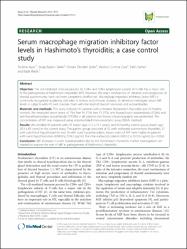Serum macrophage migration inhibitory factor levels in Hashimoto's thyroiditis; a case control study

Göster/
Erişim
info:eu-repo/semantics/openAccessTarih
2014Yazar
Ayaz, TeslimeŞahin, Serap Baydur
Şahin, Osman Zikrullah
Cüre, Medine Cumhur
Sümer, Fatih
İlkkılıç, Kadir
Üst veri
Tüm öğe kaydını gösterKünye
Ayaz, T., Sahin, S.B., Sahin, O.Z., Cure, M.C., Sumer, F., Ilkkilic, K., (2014). Serum macrophage migration inhibitory factor levels in Hashimoto's thyroiditis; a case control study. Thyroid Research, 7, article number 11. https://doi.org/10.1186/s13044-014-0011-1Özet
Objective: The cell-mediated immune process by CD4+ and CD8+ lymphocyte subsets of T-cells has a major role in the pathogenesis of Hashimoto's thyroiditis (HT). However, the exact mechanisms of initiation and progression of thyroid autoimmunity have not been completely clarified yet. Macrophage migration inhibitory factor (MIF) is commonly recognized as playing vital roles in various autoimmune diseases. Ee aimed to investigate serum MIF levels in subjects with HT and correlate them with the level of thyroid hormones and autoantibodies. Materials and methods: This study included 93 patients with untreated Hashimoto's thyroiditis and 53 healthy controls. We measured serum levels of TSH, free T4 (FT4), free T3 (FT3), anti-Thyroglobulin autoantibody (TGAb) and anti-Thyroid peroxidase autoantibody (TPOAb) in all patients and thyroid ultrasonography was performed. The concentration of MIF was measured using enzyme-linked immunosorbent assay (ELISA) method. Results: We enrolled 93 patients with HT (mean age; 31.3 ± 11.1 years), and 53 healthy control group (mean age; 29.3 ± 8.5 years) in the current study. The patient group consisted of 52 with euthyroid autoimmune thyroiditis, 31 with subclinical hypothyroidism and 10 with overt hypothyroidism. Serum levels of MIF were higher in patients with overt hypothyroidism (6300.9 ± 2504.3 pg/ml) than the euthyroid patients (3955.2 ± 3013.6 pg/ml) (p = 0.036). Conclusion: MIF increases in overt hypothyroidism due to the Hashimoto's thyroiditis. Further investigations are needed to explore the role of MIF in pathogenesis of Hashimoto's thyroiditis. © 2014 Ayaz et al.

















